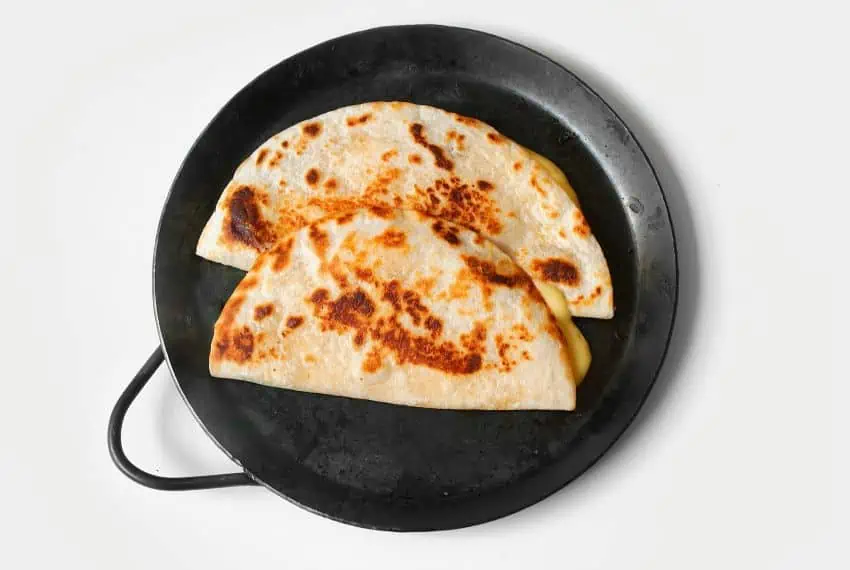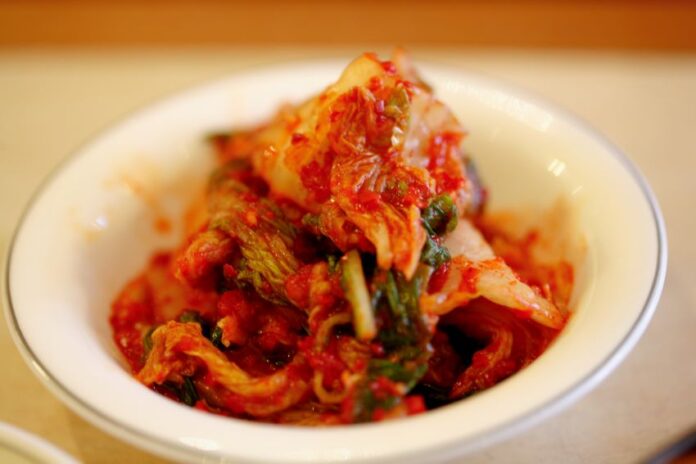Mexico has never been afraid of taking something foreign and making it better. Ask the pig. Ask shawarma. So why not kimchi? Why not throw fermented cabbage, born in Korean winters, into a hot pan with melted cheese and a tortilla, the Mexican comfort blanket? And while we’re at it, why not drop in a little anchovy to tie it all together with that quiet, briny punch for delicious kimchi quesadillas?
Let’s back up. Fish has always been part of Mexico’s cooking story. Long before missionaries and European spices arrived, coastal peoples grilled and smoked fish over open fires, folded it into masa or dried it to travel. When the Spanish arrived, they brought olive oil, garlic and wheat— and suddenly fish was being fried, stewed and served with sauces that smelled suspiciously like a monk’s dinner party.

And that’s the thing: Mexican food has always been fusion food. It’s never been static. Veracruz built entire culinary traditions around Mediterranean flavors. Baja took battered fish, a concept likely inspired by English and Asian techniques and turned it into the Baja fish taco, that glorious mess of crunch, cream, acid and spice. Mexico takes the world’s flavors and teaches them how to make new friends.
So what happens when pungent, spicy, unapologetic kimchi meets the warm, gooey embrace of a quesadilla? Magic. Fermentation has long been part of Mexico’s culinary DNA: pulque, tepache, even the tangy sourdough notes in ancient corn masa. Kimchi doesn’t clash: it thrives with Mexican ingredients. It brings a sharpness that cuts through the richness of cheese, much like pickled jalapeños have done for generations. But bolder. Louder. Kimchi is the mariachi song in the room.
Then we add anchovies. Not to make things more complicated, but to tie the story together. Mexican cooking has long used fish sauce equivalents — dried shrimp, salted fish, that fifth flavor hiding in a mole or caldo that you can’t quite name but crave endlessly. The anchovy disappears into the pan but leaves behind a savory echo. It’s the ocean’s signature on the recipe.
A kimchi quesadilla with anchovy is not fusion for fusion’s sake. It’s a reminder that borders are drawn on maps, not on dinner plates. It’s comfort food for a world that’s constantly colliding, changing, and remixing itself. It’s salty, spicy, cheesy, tangy — a bite that feels both ancient and brand-new.

And if anyone asks, “Is that authentic?” just smile. Authenticity is a story we tell ourselves to feel safe. Deliciousness, on the other hand, is real. It’s hot, messy, dripping down your fingers, and making you reach for another bite.
In the end, Mexico’s culinary genius has always been this: take what the world gives you, love it, change it, make it better. Kimchi and cheese, meet tortilla and anchovy. Now sit down, eat and let me know what you think in the comments.
Kimchi quesadillas with anchovy
Ingredients
- 2 large flour tortillas
- ½ cup sharp cheddar cheese, grated
- ½ cup mozzarella, grated
- 1 cup well-fermented kimchi, chopped
- 1 garlic clove, minced
- 2 anchovy fillets, finely chopped (or 1 tsp anchovy paste)
- 1 tsp toasted sesame oil
- 1 tsp gochujang (optional but recommended)
- 1 scallion, thinly sliced
- Butter or neutral oil for frying
- Optional garnish: sesame seeds, extra scallions, lime wedges
Instructions
- Make the flavor base: Heat a small pan over medium heat, add a splash of oil, the minced garlic, and the chopped anchovies. Stir until the anchovies dissolve into the garlic, about 30 seconds. Add the chopped kimchi, sesame oil and gochujang. Stir-fry for 2 to 3 minutes until it smells so good you consider eating it straight from the pan. Turn off the heat and set aside.
- Assemble: Lay out one tortilla. Sprinkle half the cheese, spread the warm kimchi-anchovy mixture evenly on top, then scatter the scallions. Add the rest of the cheese and top with the second tortilla.
- Cook: Heat a pan over medium heat, add a little butter or oil. Slide in the quesadilla and cook for about 2-3 minutes on each side until golden brown and crisp and the cheese is melting out the sides.
- Slice and serve: Transfer to a cutting board, slice into wedges, sprinkle with sesame seeds, maybe a squeeze of lime, and more scallions if you’re feeling fancy.
Stephen Randall has lived in Mexico since 2018 by way of Kentucky, and before that, Germany. He’s an enthusiastic amateur chef who takes inspiration from many different cuisines, with favorites including Mexican and Mediterranean.
